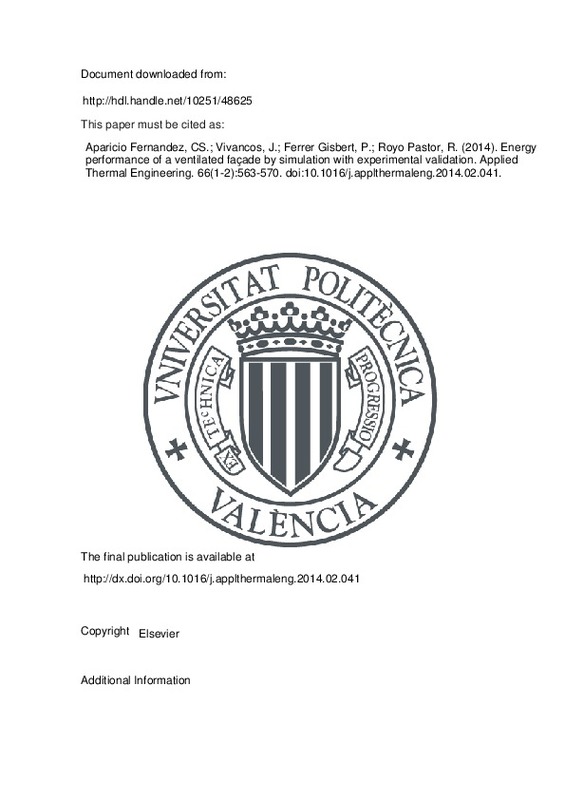JavaScript is disabled for your browser. Some features of this site may not work without it.
Buscar en RiuNet
Listar
Mi cuenta
Estadísticas
Ayuda RiuNet
Admin. UPV
Energy performance of a ventilated façade by simulation with experimental validation
Mostrar el registro sencillo del ítem
Ficheros en el ítem
| dc.contributor.author | Aparicio Fernandez, Carolina Sabina
|
es_ES |
| dc.contributor.author | Vivancos, José-Luis
|
es_ES |
| dc.contributor.author | Ferrer Gisbert, Pablo
|
es_ES |
| dc.contributor.author | Royo Pastor, Rafael
|
es_ES |
| dc.date.accessioned | 2015-04-01T10:18:12Z | |
| dc.date.available | 2015-04-01T10:18:12Z | |
| dc.date.issued | 2014-05 | |
| dc.identifier.issn | 1359-4311 | |
| dc.identifier.uri | http://hdl.handle.net/10251/48625 | |
| dc.description.abstract | A model for a building with ventilated façade was created using the software tool TRNSYS, version 17, and airflow parameters were simulated using TRNFlow. The results obtained with the model are compared and validated with experimental data. The temperature distribution along the air cavity was analysed and a chimney effect was observed, which produced the highest temperature gradient on the first floor. The heat flux of the external wall was analysed, and greater temperatures were observed on the external layer and inside the cavity. The model allows to calculate the energy demand of the building façade proposing and evaluating passive strategies. The corresponding office building for computer laboratories located in Valencia (Spain), was monitored for a year. The thermal behaviour of the floating external sheet was analysed using an electronic panel designed for the reading and storage of data. A feasibility study of the recovery of hot air inside the façade into the building was performed. The results obtained showed a lower heating demand when hot air is introduced inside the building, increasing the efficiency of heat recovery equipment. | es_ES |
| dc.description.sponsorship | The English revision of this paper was funded by the Universitat Politecnica de Valencia, Spain. | en_EN |
| dc.language | Inglés | es_ES |
| dc.publisher | Elsevier | es_ES |
| dc.relation.ispartof | Applied Thermal Engineering | es_ES |
| dc.rights | Reserva de todos los derechos | es_ES |
| dc.subject | Ventilated façade | es_ES |
| dc.subject | Rainscreen wall | es_ES |
| dc.subject | Modelling and simulation | es_ES |
| dc.subject | Energy-efficient building | es_ES |
| dc.subject | TRNSYS | es_ES |
| dc.subject.classification | PROYECTOS DE INGENIERIA | es_ES |
| dc.subject.classification | CONSTRUCCIONES ARQUITECTONICAS | es_ES |
| dc.subject.classification | MAQUINAS Y MOTORES TERMICOS | es_ES |
| dc.title | Energy performance of a ventilated façade by simulation with experimental validation | es_ES |
| dc.type | Artículo | es_ES |
| dc.identifier.doi | 10.1016/j.applthermaleng.2014.02.041 | |
| dc.rights.accessRights | Abierto | es_ES |
| dc.contributor.affiliation | Universitat Politècnica de València. Departamento de Construcciones Arquitectónicas - Departament de Construccions Arquitectòniques | es_ES |
| dc.contributor.affiliation | Universitat Politècnica de València. Departamento de Proyectos de Ingeniería - Departament de Projectes d'Enginyeria | es_ES |
| dc.contributor.affiliation | Universitat Politècnica de València. Departamento de Termodinámica Aplicada - Departament de Termodinàmica Aplicada | es_ES |
| dc.description.bibliographicCitation | Aparicio Fernandez, CS.; Vivancos, J.; Ferrer Gisbert, P.; Royo Pastor, R. (2014). Energy performance of a ventilated façade by simulation with experimental validation. Applied Thermal Engineering. 66(1-2):563-570. doi:10.1016/j.applthermaleng.2014.02.041 | es_ES |
| dc.description.accrualMethod | S | es_ES |
| dc.relation.publisherversion | http://dx.doi.org/10.1016/j.applthermaleng.2014.02.041 | es_ES |
| dc.description.upvformatpinicio | 563 | es_ES |
| dc.description.upvformatpfin | 570 | es_ES |
| dc.type.version | info:eu-repo/semantics/publishedVersion | es_ES |
| dc.description.volume | 66 | es_ES |
| dc.description.issue | 1-2 | es_ES |
| dc.relation.senia | 260251 | |
| dc.contributor.funder | Universitat Politècnica de València |







![[Cerrado]](/themes/UPV/images/candado.png)

